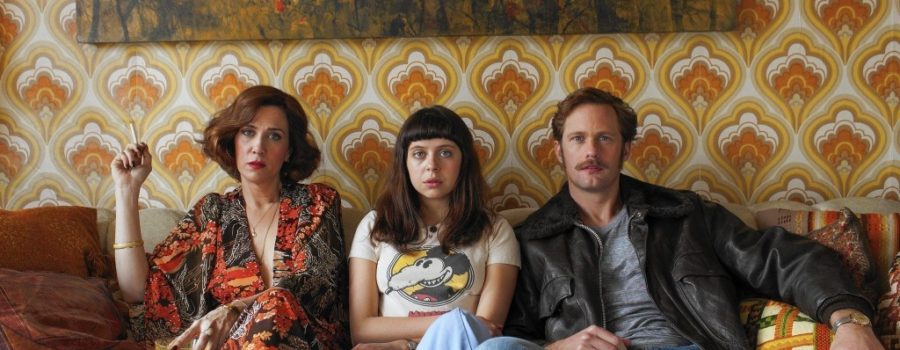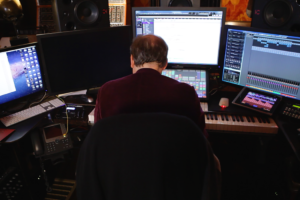 [Published at Awards Circuit] The autobiographical graphic novel, “The Diary of a Teenage Girl,” written by Phoebe Gloeckner, was adapted by Marielle Heller, who wrote the screenplay and directed the film of the same name. Refreshingly, “Diary” has sweeping, elegant shots of some of San Francisco’s lesser known views, perspectives and sceneries. Heller did a fine job of taking the viewer back to a specific time in the city; the period is the 1970s, arguably one of the most pivotal times in San Francisco history. The lingering after-effects of the hippie movement, free love and an important time for gay rights advocacy are subconsciously and simultaneously embraced and ignored by Minnie (played brilliantly by Bel Powley in her star-making performance), a 15-year-old virgin. Minnie navigates her way through a sexual awakening that is equal parts discommodious and uncompromising; it is portrayed with such brutal honesty and without judgment. Every person has gone through some sort of transition from relatively innocent child to a sexually aware adult. Some of these transitions take years, some take far less. In this film’s case, it happened to our main character in one summer.
[Published at Awards Circuit] The autobiographical graphic novel, “The Diary of a Teenage Girl,” written by Phoebe Gloeckner, was adapted by Marielle Heller, who wrote the screenplay and directed the film of the same name. Refreshingly, “Diary” has sweeping, elegant shots of some of San Francisco’s lesser known views, perspectives and sceneries. Heller did a fine job of taking the viewer back to a specific time in the city; the period is the 1970s, arguably one of the most pivotal times in San Francisco history. The lingering after-effects of the hippie movement, free love and an important time for gay rights advocacy are subconsciously and simultaneously embraced and ignored by Minnie (played brilliantly by Bel Powley in her star-making performance), a 15-year-old virgin. Minnie navigates her way through a sexual awakening that is equal parts discommodious and uncompromising; it is portrayed with such brutal honesty and without judgment. Every person has gone through some sort of transition from relatively innocent child to a sexually aware adult. Some of these transitions take years, some take far less. In this film’s case, it happened to our main character in one summer.
Minnie’s journey of self-discovery is perhaps one of the most disquieting but honest coming-of-age stories in recent memory. Though tastefully made and, for the most part, well-written, one cannot help but cringe at certain moments within the script. As aforementioned, Minnie is only 15 years old. She has her first sexual encounter with her mother’s (played with fine nuance by the ever-expanding Kristin Wiig) degenerate boyfriend, Monroe (played indifferently by the stone-faced Alexander Skarsgård), who is over twice her age. Skarsgård has gotten by in the film industry largely based on looks and family name alone; his father, Stellan, is a talented and accoladed thespian. Throughout her various sexual exploits, induced by alcohol, drugs, and copious amounts of misplaced desire, Minnie spirals out of control and loses some self-dignity in the process. She is, more or less Gloeckner, which is admirable and courageous to portray such an unflinching story of a sexual awakening at the tail-end of San Francisco’s glory days, because it his her own singular experience. Her character, though, however much of a variation it is from her actual teenage self, never undergoes a large enough change (albeit an apparent arc) within the confines of the film to fully engage the viewer. There is only so much character development you can accomplish in 102 minutes. Minnie is mundane, though extremely precocious. She puts continuous blame on other people, including her mom, and uses them as a rationalization for her acts.
Minnie is not our typical protagonist. In fact, she is not meant to be a protagonist at all, simply a young person trying to find her way in the world. Free love and the American hippie counter-culture was founded, blossomed in and encapsulated San Francisco in the 1960s, and the aftershock (pun intended) of that phenomenon still affected the city in the 1970s. It still does to this day. Minnie was also a product of her surrounding culture. Her mother was uncaring and uninvolved, not ever allowing her to see the error in her actions nor being engaged enough to even know what was happening with her daughter. Wiig deserves immense credit for showing her dramatic chops with as much effectiveness as those of her comedic turns.
This story, apart from having a rather boring central character, is told by somebody who no doubt has a unique way of looking at the world. Heller had such an opportunity to parallel what was going on with Minnie’s life to the important sociocultural events happening around her; it would have been appropriate to add more of the post-Vietnam San Francisco hippie culture and the rise in homeless. At the very least, Heller could have expounded upon capturing the time period with more cultural subtext. Instead, she focuses on Patty Hearst (this was not in the original graphic novel), and makes a feeble attempt at drawing connections between Ms. Hearst and her kidnappers and Monroe and Minnie’s relationship. The likeness is a stretch. She could have even contrasted her life with certain sociocultural movements in San Francisco, namely Harvey Milk’s extraordinary rise to power; his sincere dignity and struggle to prove that he had the right love whomever he wanted to would have been a welcome antithesis to Minnie, who had little regard for the value love simply because she was naive and had an unsureness that every teenager has at some point.
Without much cultural context to infer without doing research, the film floats, creating a dreamlike atmosphere at times. Though this works to the films advantage aesthetically and emotionally, it hinders the plot progression. Though there is an interesting blend of animation throughout the film to try and capture Gloeckner’s unique artistry, it further takes away from Minnie’s character development and is not effective in providing a complete enough glimpse into her imagination; Heller could have used Gloeckner’s graphic novel more wholly to illustrate Minnie’s personality. Instead, it seems Heller has attempted and, largely, failed to do what writer and director Jonathan Levine did with his debut, “The Wackness,” which is a much more fully realized vision. Levine utilized its New York settings well to combine animation, graffiti, and live shots that gleefully come together to express an earnest mind of a teenager in transition to adulthood.
What makes the film work is that it is raw and it does justice to Minnie’s story. However, Minnie is not the multidimensional character she needs to be to add emotional weight or any lasting resonance after viewing. What elevates Heller’s occasionally lackluster script in terms of character development is made up for by her direction and the performances (for the most part) she brings out of her cast. “The Diary of a Teenage Girl” is an uncomfortably fascinating look into a trouble child’s coming-of-age experience with commendable merit from its wonderful shots of San Francisco (from the breathtaking Aquatic Cove to the welcome dirtiness of Haight-Ashbury) to its knockout performances in Kristin Wiig and relative newcomer Bel Powley. Powley understands Gloeckner’s Minnie, and immerses herself into the role so well that it leaves viewers both captivatingly perturbed and astounded. Fans of chameleon comedian and dramatic character actor Christopher Meloni can even expect an enjoyable and textured cameo. It is bracing that the industry is shifting to allow more female voices in cinema, particularly t0 the coming-of-age format, which is becoming sizably worn and overdone. However flawed this film may be in certain aspects, it is a praiseworthy effort for newcomer Marielle Heller, and it will be a pleasure to watching her evolve as a filmmaker in the future.
“The Diary of a Teenage Girl” was distributed by Sony Pictures Classics and released Aug. 28, 2015. Check out the trailer for Bel Powley’s next big project, Carrie Pilby, released this week!
GRADE: (★★★)








Leave a Reply
Your email is safe with us.